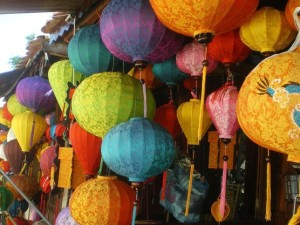Hoi An – The Colour of a City
Everyone who ever traveled to Hoi An knows that as early as the 16th century, it was well renownead as a frenetic and animated trading port and a popular stopover for both foreign traders and travelers. Crews of trading ships from East Asia to Western Europe turned the port city, as a special exception of history, into a rendezvous and centre promoting the exchange of East – West cultures and interaction of generations of people from countless nations. This international communication lead to a noble way of life, highlighting the feelings and sentimental attachments in the code of conduct handed down through many generations and forming the social identity of the people of the ancient port city.
 Evidence of this uniqueness is partly visible in the outer appearance of the streets with old, moss-encrusted architectural works with their ancient decorative patterns and in the extant names of the lanes. It can be found in the clubs and head quarters of the guilds of different styles and worshiping statues imbued with distinctive East Asian features of the glorious past. The beauty of the city’s old streets expresses something that cannot be easily captured, with their native cultural depth that has been formed and nurtured from integration and creation, hence the particular and unmistakable colour of the city.
Evidence of this uniqueness is partly visible in the outer appearance of the streets with old, moss-encrusted architectural works with their ancient decorative patterns and in the extant names of the lanes. It can be found in the clubs and head quarters of the guilds of different styles and worshiping statues imbued with distinctive East Asian features of the glorious past. The beauty of the city’s old streets expresses something that cannot be easily captured, with their native cultural depth that has been formed and nurtured from integration and creation, hence the particular and unmistakable colour of the city.
Isn’t it the reason why Hoi An is always animated and busy, but not boisterous, sustaining its natural peace and tranquility in spite of the changes that time has brought. People of all ages and nationalities, who have mingled with the life of the town, weaved through the flow of its traffic, visited its old sites of interest, has a cordial talk with its people, and shopped here and there, will quickly realize the gentleness and elegance of the ancient town. This simple and plain cultural quality is just like an early morning mist shrouding the environment and social life naturally, unpretentiously, and exactly as the trading port is called in Vietnamese.
These days, on the evening of the 15th day of the lunar months, all homes in the city douse the electric lights and hang up their fancy lanterns of all shapes and forms. Loopahs and pumpkins, octagons and merry-go-rounds, all flickering from dusk till dawn turn the old streets into a glittering fantasy land, attracting more and more people onto the roads. One day as the viewers quietly walked on and on, contemplating the lanterns and the streets, I was one among them, mixing and mingling with them and making the mose of the lofty pleasures of contemplation, windows-shopping or enjoying the evening snacks and delicacies. At every corner, Hoi An was engulfed in an atmosphere of open-heartedness, rustic yet elegant, simple yet colourful, plain as the chracters of its soil and the virtues of its folk, something intermingled between the true and the false, between poetry and painting, between the present and the past between introspection and external settings. On such nights, you want to stay awake all night with Hoi An since wherever you go you’ll get some feeling of profound attachment.
I soon found myself in an old house, a very wealthy merchant’s home, built 400 years ago, still standing there intact as a historical witness to the city. With the exception of two brick walls, it was built of iron wood, glistening with the passage of time, decorated with vertical and horizontal wooden plaques, panels and couplets flowing calligraphy in the lounge, including this exceptionally interesting poem:
As the apricot blooms try to blossom before the others,
How beautiful those snow-white flowers on the distant mountains are
Contemplating the spectacular scenery,
who could realizeThe beauty of spring at the harmonious moment of heaven and earth
The private properties of the wealthy in Hoi An always includes a “back garden”, unlike other areas of the country. Often this area is doted with rare bonsai plants for the owner to enjoy during leisure times, feasting his eyes on the miniature landscapes and reciting poems.
Thuong Chua Cau – Ha Am Bon is the main axis that leads to the centre of the town. Along its side runs the Hoai Pho River weaving through the old streets. This name brought me some sweet nostalgia of the past. It was a Vietnamese articulation of the term “Faifo” given by the European merchants, implying an urban area with a trading port, or a “port city”, to be brief. The Chinese in Hoi An, however, pronounced it in their own way, transcribing it into “Hoai Pho”, to signify their longing for the ancient town. Either term accurately expresses what exist in Hoi An.
And like the feelings invoked by the name “Hoai Pho”, those who travel along the ancient streets of Hoi An seem to go back against the flow of history, into the depth of its cultural layers. There, in the 17th century, it was a prime center for trans-shipment and distribution of commodities of the South. Besides aloes and gold, its fine arts articles accounted for a high percentage of the exports of the Dai Viet. The “Phu bien Tap luc” (Miscellaneous Annals – Revised and Amended) by Le Quy Don records: “Hoi An has so many commodities on display and on sale that one cannot remember them all. There are silk and silk products, medicinal herbs and pharmaceuticals, cosmetics and costumes, high-quality paper and stationery, glass and fans, pins and needles, furniture and pottery, copper and silver wares, tea and dried foods, candies and cookies. It goes on and on”.
Thus you may see that as early as the 17th century, the handicrafts produced by private house holds and guilds developed well. The artisans of a craft would be living in the same communes, such as carpentry at Kim Bong, ceramics at Thanh Ha, mental casting at Phuoc Kieu, textile at Minh Huong. It is quite well known that the ancient houses and monuments of the town with delicate carvings were made up virtually by the clever hands of Kim Bong and Phuoc Kieu artisans, that is, these workmen made no small contribution to the formation of the cultural values of these old streets. Later, they were recruited by the Nguyen Court to construct the ancient capital of Hue.
So where are these renowned artisans today? I immediately felt some touch of nostalgia when I suddenly recalled the verses of late poet Vu Dinh Lien:
People in the days of yore,
Where are you now?










